10 Best AI Interior Apps and Tools to Create Interior Design Images
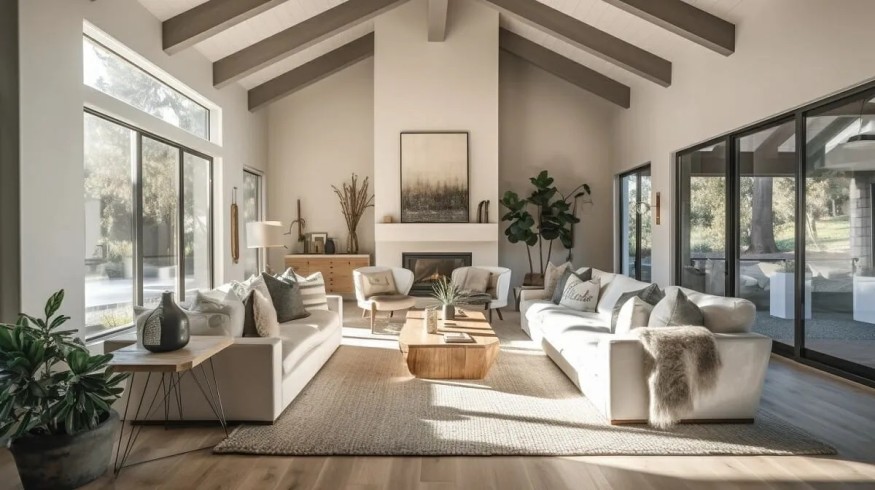
In the ever-evolving realm of interior design, artificial intelligence (AI) has emerged as a revolutionary force, simplifying design choices and reshaping how we envision our living spaces. These AI tools act as trusted companions, assisting in brainstorming and vendor research and even providing a glimpse into the future through mesmerizing 3D visuals. The future is now, and AI rapidly transforms the interior design landscape with its accessible and user-friendly tools. Our journey has led us to discover some outstanding AI internal design apps, and we're excited to share a curated list of the best tools currently making waves in 2024.
How to Harness the Power of AI in Interior Design
Like any specialized tool, AI for interior design requires a bit of learning. However, these programs are designed to be user-friendly, particularly once you grasp how to communicate effectively through simple text commands. Here's a step-by-step guide to using AI interior design tools:
Choose the Right AI Interior Design App:
Select an app with a robust AI component that adapts to your needs. The top options are explored in detail below.
Define Your Preferences:
Set clear parameters by specifying your preferred room, style, colors, furniture arrangement, budget, and other key elements. Knowing what you want and how to communicate it is crucial.
Specify Visualization Type:
Clarify the type of visualization you desire, whether it's 3D, CAD drawing, mood board, or floor plan. Knowing the level of detail and the format you prefer will yield the best results.
Provide Feedback:
Collaborate with the AI by providing feedback on the generated designs to refine the final output.
Experiment with Different Tools:
Try different tools to gather a myriad of inspiration. Combining two or more tools can often lead to the most satisfying results.
Consider Professional Assistance:
Explore the synergy between AI-assisted interior design and professional designers for the ultimate design experience.
Choosing the Right AI for Room Design
Selecting the ideal AI tool is crucial for creating your dream space. Consider features, user-friendliness, reviews, cost, and support options. Below, we present the top-rated interior AI apps in 2024:
1. Midjourney

How It Works:
Craft stunning artificial intelligence interior designs through accurate and helpful commands on Midjourney. It generates AI images based on your prompts, allowing you to select your favorite or request a higher-resolution version.
Pros:
- Realistic renderings and adaptations are available.
- Various settings for tweaking your rendering.
- Allows the use of reference images in combination with prompts.
Cons:
- Not specific to room dimensions.
- Limited editing capabilities.
- Accessible only via Discord.
- Available for paid accounts only.
Pricing:
Midjourney offers four subscription plans, from Basic at $10/mo to Mega Plan at $120/mo.
2. Decorilla Online Interior Design
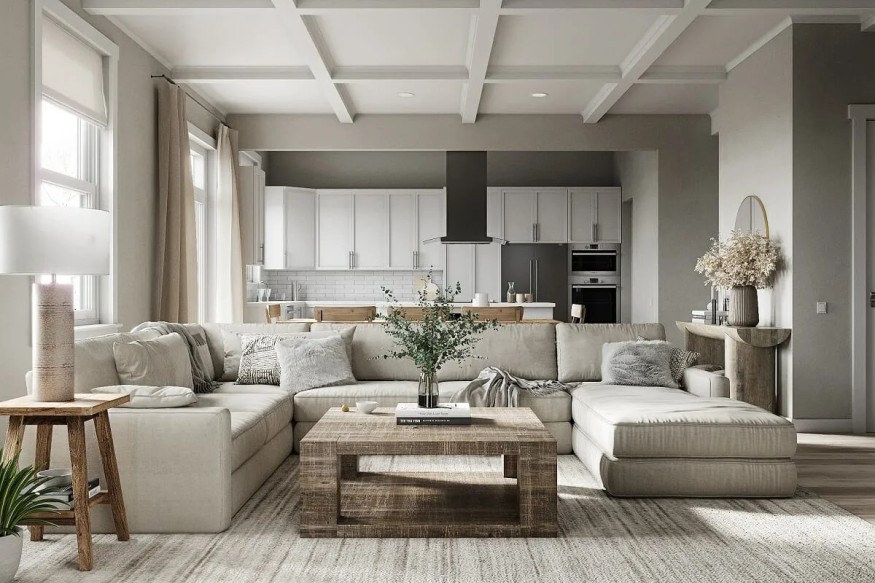
How It Works:
Decorilla integrates AI tools, Augmented Reality, and Virtual Reality into its unique approach. After starting with a style quiz, clients receive accurate 3D models, inspiration from multiple designers, professional guidance, and an online shopping list.
Pros:
- Hybrid AI model for customized designs.
- Incorporates new and existing pieces accurately.
- Provides floor plans, color palettes, and professional guidance.
Cons:
- There is a more extended waiting period compared to some AI apps.
- Integration of AI is still in progress.
Pricing:
Decorilla's once-off cost structure ranges from $539 to $75/h for a full-room design.
.
3. DreamStudio (Stable Diffusion)
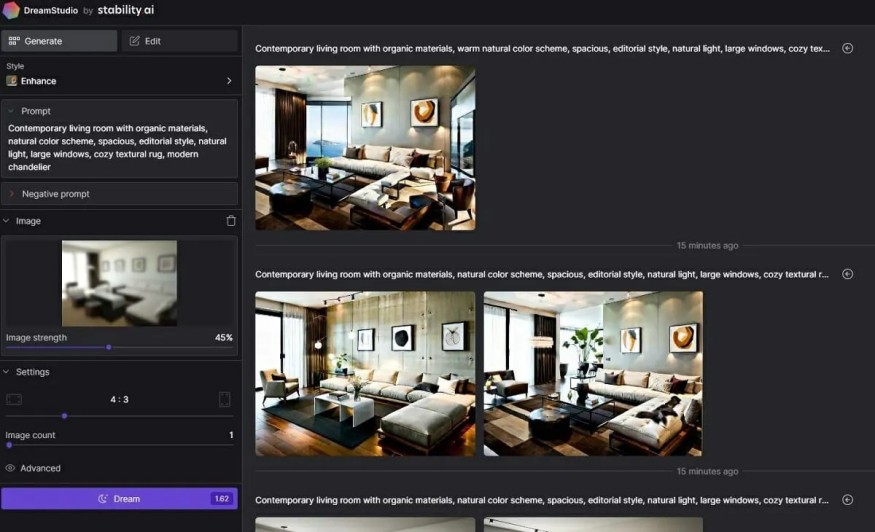
How It Works:
DreamStudio uses the Stable Diffusion image generation model, allowing the combination of prompts with reference images. It offers settings to specify prompt and image strength for more control.
Pros:
- Realistic renderings with customization options.
- Accessible to anyone with an email or Google/Discord account.
Cons:
- Options can be overwhelming.
- Initial credits expire and require additional purchases.
Pricing:
Costs depend on settings, with a minimum purchase of $10 for 1,000 credits.
4. DiffusionBee

How It Works:
Branched off Stable Diffusion, DiffusionBee allows AI-generated interior design offline. Users can upload prompts or images to generate designs and edit them using in-painting or out-painting options.
Pros:
- It is free, convenient, and secure as it runs offline.
- Local saving of image files.
- Wide range of options and modification capabilities.
Cons:
- Restricted to macOS.
- Processing may be slow on older computers.
Pricing:
DiffusionBee is 100% free.
5. OpenArt
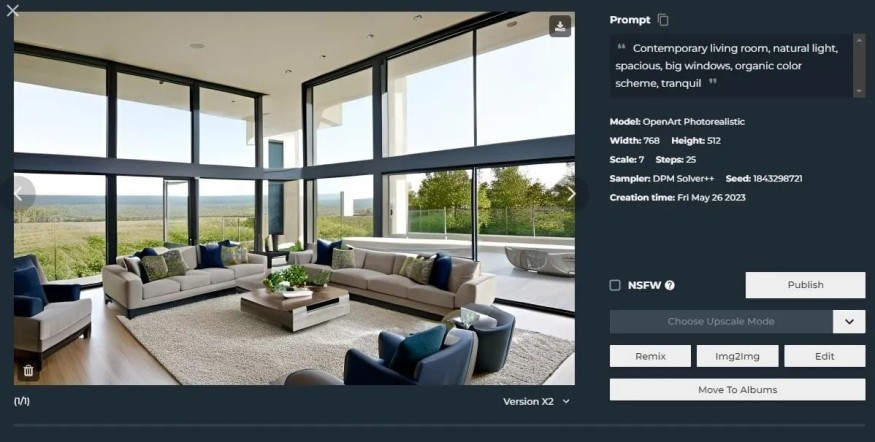
How It Works:
OpenArt uses Stable Diffusion and Dall-E 2 models for image generation. It offers various settings and options, allowing users to switch between public AI models for unique outputs.
Pros:
- Wide range of settings and options.
- Free to start with 1,000 credits.
- Option to add negative prompts.
Cons:
- Requires a Google or Discord account.
- There are no modification options for renderings.
Pricing:
Free trial with paid versions ranging from $12/mo to $56/mo.
6. RoomGPT AI Interior Design

How It Works:
RoomGPT follows a simple upload-and-adapt model. Users log in with a Google account, upload a room image, select room types and styles, and receive AI-generated redesigns based on preferences.
Pros:
- Easy to use with quick results.
- Customer support is available with paid accounts.
- Renderings are based on the specific room.
Cons:
- The free version has limited styles.
- There is no prompt option in the free version.
- Cap on the number of renderings without additional credits.
Pricing:
Free trial with Pro Plan at $15/mo and Business Plan at $30/mo.
7. Chat GPT 4 Dall-E
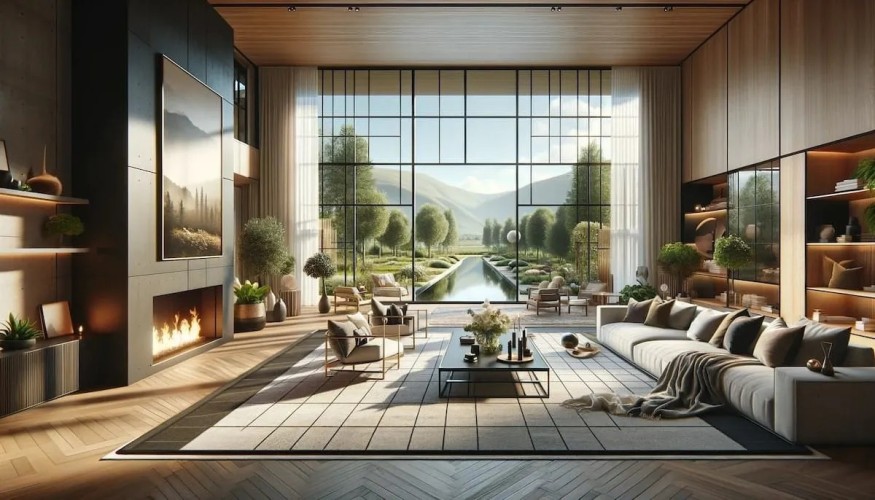
How It Works:
Chat GPT 4 Dall-E is part of the OpenAI platform, offering image creation through text prompts or inspiration image uploads. It provides different angles, versions, and edits for an immersive experience.
Pros:
- Image creation with feedback and modification options.
- Capable of creating shopping lists.
- Subscription to Chat GPT Plus is required at $20 per month.
Cons:
- Interiors may look unrealistic with trickier prompts.
- It is suited for creating artistic images.
8. Bing Image Creator

How It Works:
Powered by Dall-E 2, Bing Image Creator generates realistic renderings based on prompts. Users can create images, from AI artwork to room designs, by logging in with a Microsoft account.
Pros:
- Realistic renderings with easy prompts.
- Fast image generation.
- Free to use with a reward system.
Cons:
- Requires a Microsoft account.
- There is no feedback option after initial renderings.
- Renderings are available only in a 1:1 aspect ratio.
Pricing:
Free to use, with processing time increasing after 25 image creations per day.
9. Fotor AI Interior Design App
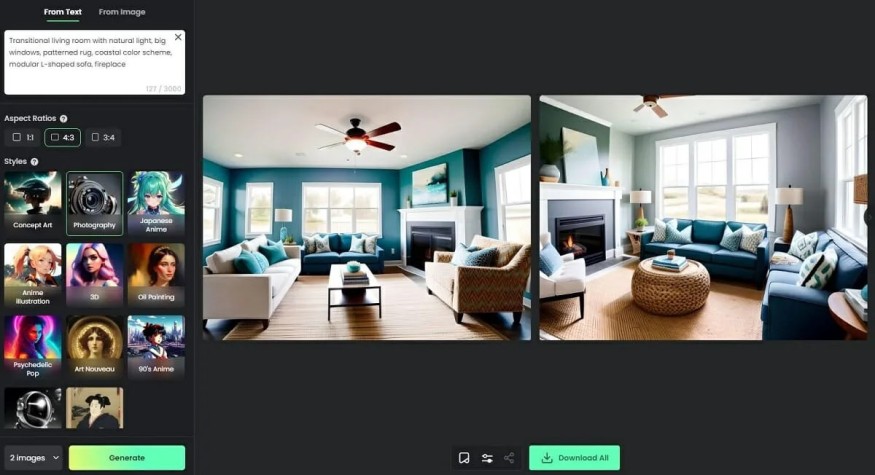
How It Works:
Fotor has a user-friendly interface allows users to select prompts or upload images. Specify the aspect ratio, rendering style, and the number of images to generate.
Pros:
- High-quality images with a convenient interface.
- Accessible for free with an account.
Cons:
- The initial four free credits expire.
- There are no modification options; prompts need rewording.
Pricing:
Paid monthly subscriptions start at $3.33, with credits available from $19.
10. AI Room Planner
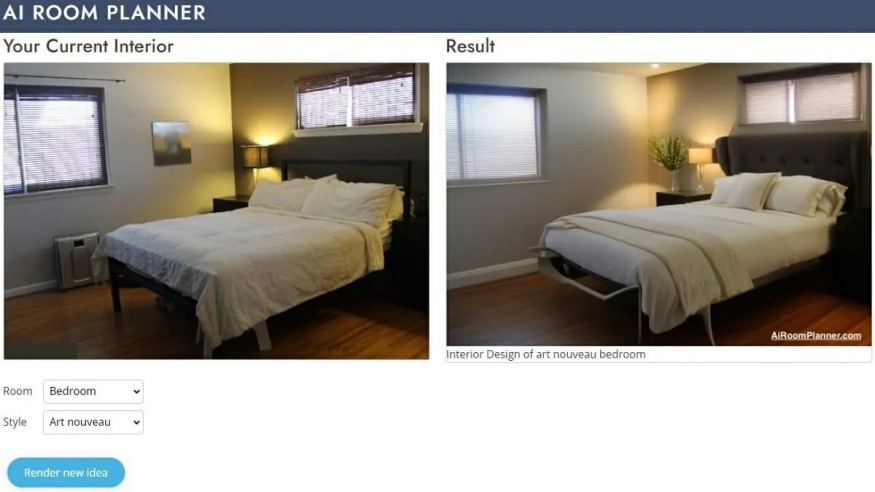
How It Works:
AI Room Planner is a straightforward upload-and-transform app for room redesign. Users upload a photo and select room type and style, and the AI generates redesigns for exploration.
Pros:
- Free and easy to use.
- Specific to your actual space.
Cons:
- Room prompts aren't available.
- Limited customization options.
Pricing:
AI Room Planner is free to use.
Pros and Cons of Using AI in Interior Design
The integration of AI into interior design comes with both advantages and limitations. Understanding these aspects is crucial for leveraging AI effectively:
Benefits of an Interior Design AI App
1. Design Inspiration: AI platforms with uniquely generated images expand creative possibilities.
2. Cuts Time and Initial Costs: AI-powered tools streamline the design process, reducing time and initial design costs.
3. Accessibility: AI interior design tools are available to anyone with an internet connection; some are even free to use.
4. Customization and Personalization: AI algorithms can learn from user preferences, providing more personalized design experiences.
5. Ease of Use: Some AI-generating platforms are straightforward, requiring minimal learning.
Drawbacks of Interior AI Creation
1. Lack of Human Touch: AI may lack the nuanced creativity and authenticity a professional designer can provide.
2. Limited Emotional Understanding: AI algorithms may struggle to interpret complex emotional or sensory design aspects.
3. Data Dependency: The quality and relevance of AI suggestions may be affected by the underlying data used for training.
4. Technical Limitations: AI tools may struggle with intricate design tasks, accuracy, or high levels of customization.
5. User Learning Curve: Effectively using an interior AI may take time as users familiarize themselves with the platform's features.
6. Duplicate Content: AI design generators could produce similar content for multiple users using the same or similar prompts.
Frequently Asked Questions
With groundbreaking technology, questions arise. Here are some frequently asked questions about AI interior design:
How Does AI Help Interior Design?
AI assists in spatial planning, furniture selection, color palettes, and material choices, saving time and inspiring creativity. AI-powered software analyzes vast amounts of data to generate insights and recommendations, considering trends, preferences, and global design patterns.
What are the Benefits of Using AI in Interior Design?
- Design Inspiration
- Cuts Time and Initial Costs
- Accessibility
- Customization and Personalization
- Ease of Use
Can AI Interior Designers Replace Human Designers?
While AI can automate certain aspects and provide insights, it is unlikely to replace human designers. Interior design involves a creative element that requires human intuition, emotion, and personalization.
Is AI Interior Design Free?
While some AI interior design tools offer free usage, advanced or comprehensive ones often require payment or operate on a credit system. Tools like DiffusionBee and OpenArt provide free options, while others may have associated costs.
How Does AI Impact the Customer Experience in Interior Design?
AI-powered platforms make interior design more interactive and accessible. Clients can explore and visualize designs remotely, and AI bots assist in real-time communication between designers and clients, providing an immersive and interactive experience.
In conclusion, the world of AI interior design is filled with possibilities and advantages. While AI tools can inspire and assist, combining them with human expertise and creativity often leads to the best design outcomes. As we embrace the future of design, these AI tools open up new horizons, making the process more efficient, accessible, and enjoyable for everyone.
Related Article : AI Visualization of Architectural Materiality in Contemporary Design













